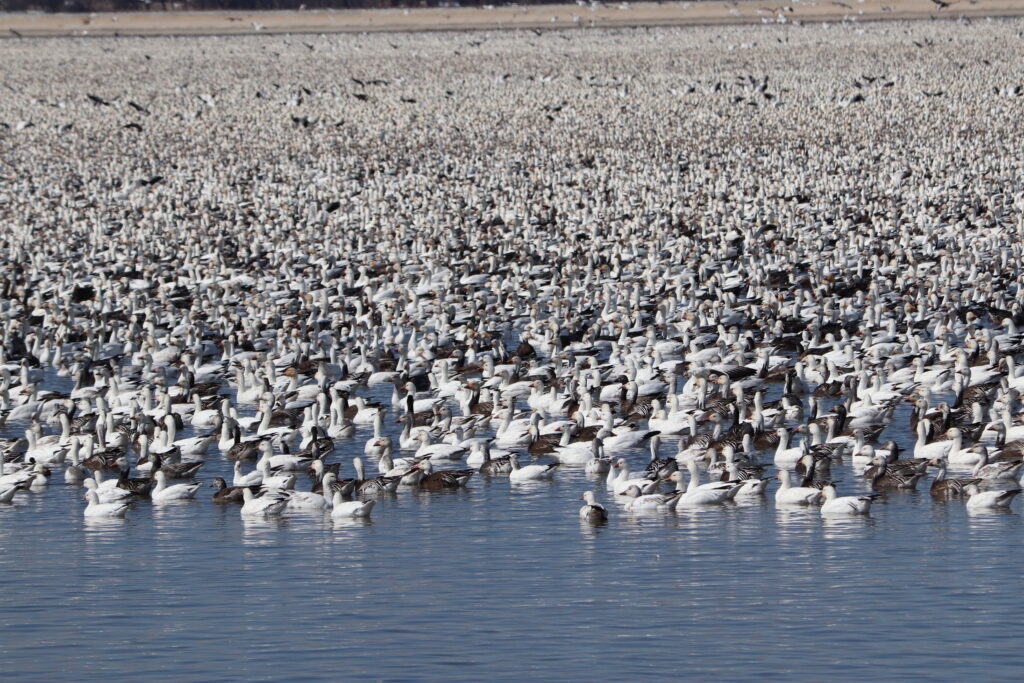by Chris Shank, Loup Civil Engineering Compliance Tech & Michael Gutzmer, New Century Environmental
The migration of waterfowl (ducks and geese), shorebirds and neo-tropical migrants (songbirds) has been in process since millennia started, way back when. Various groups and certain species of birds have used traditional flyways to plot their course for warmer and less energy-expending locations to overwinter during parts of their life cycle. In our area of the Great Plains, the central flyway is a traditional route that many of our local avian friends have selected.
The spring migration of ducks and geese in Nebraska is hard to ignore as endless streams of vocalizing ducks and geese fly overhead before landing in open water and fields to forage. This year, the spring migration of geese appears to be even more pronounced than normal.
The geese are attracted to the many agricultural fields with minimal snow cover — primarily corn fields — where they can canvass for waste grain in the late winter sun.
Columbus, however, boasts the presence of Lake Babcock, which is like a Ritz Carlton hotel to migrating birds. It has hundreds of acres of open water wetlands (palustrine wetlands) where waterfowl can easily obtain aquatic plant fragments, lotus fragments and seeds, invertebrates and plenty of water to wash down the protein-rich kernels from local farm fields. The best of all bird rest stops is right outside our back door.
As climate shifts, from colder to warmer and warmer to colder again, bird flight patterns may slightly shift and this may help explain the increase of birds in our area. We have the Loup and Platte Rivers coming together here, Lake Babcock and Lake North, and Wilkinson Wildlife Management. The number of sand pit developments have also increased over the past several years, adding even more water attractions for geese and other birds.
A spotting scope or binoculars can be helpful to view distant birds on the water. The many species of ducks and geese following the Missouri River corridor northward are often trailed by bald eagles. The Rainwater basin is not only a great area to view shorebirds, but is also great for viewing a variety of ducks and thousands of geese. Columbus is blessed with ample aquatic resources, let’s get out and enjoy them!
More about the RAINWATER BASIN
The Rainwater basin provides one of the world’s greatest waterfowl migration spectacles. Possibly tens of millions of waterfowl descend on the Rainwater Basin region of south-central Nebraska each spring, not as a destination, but as a way station between southern wintering retreats and northern nesting grounds. To date, 257 bird species have been observed in the Rainwater Basin.
For one species, the white-fronted goose, the Rainwater Basin has become a critical stopping point for northward migration. Approximately 90 percent of the mid-continent population of white-fronts stage on these wetlands. An estimated 7-9 million ducks and 2-3 million geese annually stop in the Rainwater basin, including:
- 50 percent of the mid-continental mallard population
- 30 percent of the continental northern pintail population
- 25 species of waterfowl
- 27 species of shorebirds
- 3 endangered and threatened species (whooping crane, piping plover, and least tern)
LOCATION

The Rainwater Basin area stretches from Seward County west of Lincoln to Gosper County near Lexington, spanning 21 counties and nearly 6,200 square miles. Rainwater and snowmelt fill the basins every year, just in time for the waterfowl that will depend on it for food, roosting and shelter. A generous supply of seeds and tubers from wetland plants, as well as corn from surrounding farms, provides the required energy for pairing and the continued migration. Later in the spring, these shallow basins warm, brewing up a protein-rich soup of invertebrates. Few birds will remain in the basins to raise young, with most traveling north to the Dakotas and Canada to breed.
HISTORY
Before European settlement, wetlands were plentiful from the gulf coast to the arctic. The Rainwater Basin was a large part of a chain of wetlands where waterfowl could briefly visit on their way northward. Today, only 10-20 percent of the original 200,000 acres of wetlands remain. Many of these wetlands were drained or altered for agriculture, making each wetland more vital to the Central Flyway than ever.
CONSERVATION
The Rainwater Basin Joint Venture was started in 1992 under the North American Waterfowl Management Plan to protect remaining wetlands, and to restore drained and altered wetlands to help in meeting the demands of migrating waterfowl and shorebirds. The Joint Venture is a partnership between state and federal agencies, non-governmental organizations, landowners and farmers to address natural resource issues through various projects that improve migratory bird habitat.
Other wildlife such as white-tailed deer, coyotes, muskrats, prairie dogs, and beaver can be seen in and around Rainwater Basin wetlands. There are 84 publicly owned Rainwater Basin wetlands totaling over 28,600 acres.

